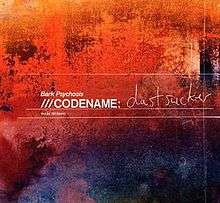Codename: Dustsucker
///Codename: Dustsucker is the second studio album by British post-rock band Bark Psychosis.[7] It was released on 28 July 2004 on Fire Records. The album was recorded at DustSuckerSound, a private studio run by Bark Psychosis member Graham Sutton in east London, between 1999 and 2004. It notably features the contributions of Lee Harris, the drummer and percussionist of early post-rock purveyors Talk Talk.
| ///Codename: Dustsucker | ||||
|---|---|---|---|---|
 | ||||
| Studio album by | ||||
| Released | 28 July 2004 | |||
| Recorded | 1999–2004 | |||
| Studio | DustSuckerSound in London | |||
| Genre | Post-rock | |||
| Length | 50:18 | |||
| Label | Fire | |||
| Producer | Graham Sutton | |||
| Bark Psychosis chronology | ||||
| ||||
| Review scores | |
|---|---|
| Source | Rating |
| AllMusic | |
| The Encyclopedia of Popular Music | |
| Mojo | |
| Pitchfork | 7.7/10[4] |
| Stylus Magazine | A[5] |
| Uncut | |
"400 Winters", along with remixes of three of the album's other tracks, was released as an titled "400 Winters" EP in 2005.
Composition
The band continues to use conventional rock instruments in songs that are structured unconventionally, as they did in their earlier releases. Rather than the familiar alternation of verse and chorus, the songs mostly develop as a succession of related sections. "400 Winters" has an intro, a verse, a long chorus-like section, then the rhythm and arrangement change for a long coda section, which fades to be replaced by a chord sequence on piano and what appears to be a distorted answerphone message. "Shapeshifting" follows a similar structure. "Burning the City" is based around a three bar pattern, in contrast to rock's usual 4, 8 or 12 bar structures.
Track listing
All tracks are written by Bark Psychosis.
| No. | Title | Length |
|---|---|---|
| 1. | "From What Is Said to When It's Read" | 5:27 |
| 2. | "The Black Meat" | 6:50 |
| 3. | "Miss Abuse" | 6:11 |
| 4. | "400 Winters" | 5:48 |
| 5. | "Dr. Innocuous/Ketamoid" | 1:04 |
| 6. | "Burning the City" | 5:11 |
| 7. | "Inqb8tr" | 8:00 |
| 8. | "Shapeshifting" | 6:03 |
| 9. | "Rose" | 5:50 |
Personnel
Musicians
- Graham Sutton – vocal (i, ii, iii, vi, vii), guitar, bass guitar, piano, keys, melodica, e-mu
- Lee Harris – drums, percussion
- Colin Bradley – guitar
- Pete Beresford – vibraphone
- Rachel Dreyer – piano, vocal (viii)
- T. J. Mackenzie – trumpet
- Anja Buechele – vocal (iv, vi)
- Chicken – gonk vocal
- Neil Aldridge – indicators
- Shaun Hyder – sindhi tamboura
- David Panos – bass guitar
- Alice Kemp – bowed guitar
- Silke Roch – vocal (ix)
- Mark Simnett – found drums
- Del Crabtree – found trumpet
Technical personnel
- Graham Sutton – engineering, production, mastering
- Noel Summerville – mastering
References
- "Codename: Dustsucker – Bark Psychosis". AllMusic. Retrieved 27 June 2018.
- Larkin, Colin (May 27, 2011). "The Encyclopedia of Popular Music". Omnibus Press – via Google Books.
- Segal, Victoria (June 2018). "Bark Psychosis: Codename: Dustsucker". Mojo (295): 103.
- Ubl, Sam (4 October 2004). "Bark Psychosis: Codename: Dustsucker". Pitchfork. Retrieved 27 June 2018.
- Southall, Nick (26 July 2004). "Bark Psychosis – ///Codename: Dustsucker – Review". Stylus Magazine. Archived from the original on 9 January 2016. Retrieved 21 February 2020.
- "Bark Psychosis: Codename: Dustsucker". Uncut (89). October 2004.
- "The Quietus | Features | A Quietus Interview | I Put A Spell On You: The Story Of Bark Psychosis & Hex". The Quietus.